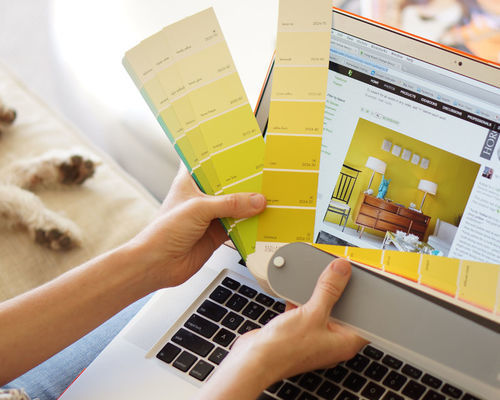Homeowners and designers know what a difference color makes in a home. They can spend hours pouring over print and online images in search of the perfect hue. But sometimes the paint color in the image doesn’t end up looking the same on the wall. Why?
“Have you ever bought a piece of clothing online, thinking it’s one shade of a particular color, only to find that it’s completely different when it arrives?” asks photographer Christopher Stark. “Same goes for photos.” We talked with Stark, photographer David Duncan Livingston and designer Jean Verbridge to get the scoop on how you can find and get the perfect color for your walls.

Color 1: David Duncan Livingston, original photo on Houzz
What makes a color look different from space to space? The ambience, look and feel of a color are highly dependent on an area’s light and surroundings. The quality of the light in the room and how it hits each object makes a big difference. “The light can create color casts that change the appearance of the colors,” says Livingston. “Think of the coolness of fluorescents or the warmth of incandescents.”
“I usually pick the final color based on the time of day I’ll be spending the most time in that room,” says Verbridge. “It’s also easier and less expensive to purchase small paint samples instead of painting an entire room and finding out you don’t like the color.”
Furniture, trim and accessories can change the look of a color from one room to another as well.
Related: Consult a Professional Painter First

Color 2: David Duncan Livingston, original photo on Houzz
Why do colors look different in photos and online? The changes in color and light in different rooms are captured in photos — and often are more exaggerated, as Livingston illustrates here. While most professional photographers work to correct these color shifts and make the colors clearly, the photos will show up on different devices in different ways. “When an image is reproduced on a laptop, a magazine page or a photographic print, each of the outputs is slightly different, and the colors may shift a bit,” says Livingston.
Photographers set their monitor colors to the same calibration, which allows them to get very close with color accuracy in postproduction. But the same standard doesn’t apply to other devices. “Most consumers are not looking at things on a calibrated monitor,” says Stark. “I wouldn’t make a major decision that isn’t reversible without seeing [the color] in person.”

Color 3: Contemporary Dining Room, original photo on Houzz
How do I get a color I love online into my home? While Verbridge doesn’t recommend going with a color listed online or in a magazine — since your own light will likely make it look very different in your space — there’s still a way to get the hue you’re looking for: Get a hefty supply of paint chips to find a match. “Put the color match next to the photo on your screen and squint your eyes. If the two can blur together, you have a match,” says Livingston. Try a few samples from that same paint strip to test in your room to find the best one for your room’s lighting and surroundings.
Related: A Color Guide for Every Room in the House
By Vanessa Brunner, Houzz
 Facebook
Facebook
 X
X
 Pinterest
Pinterest
 Copy Link
Copy Link
